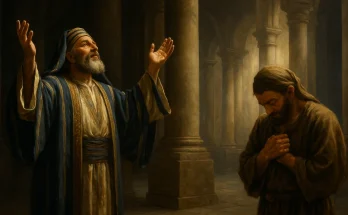Why the Seven Seals Matter
What if the seven seals of Revelation aren’t just distant, mysterious symbols—but a message of hope and justice for us today?
Revelation often feels overwhelming. Strange images, intense judgments, and heavenly visions can leave us unsure where to begin. But this final book of the Bible wasn’t written to confuse us—it was written to bless us. God gave it to the early church during a time of suffering. And through it, He gives us strength to endure and trust His plan.
At the heart of Revelation lies a scroll—sealed with seven seals—that no one can open. That is, until Jesus steps forward. He’s not just the Lion of Judah—He’s the Lamb who was slain. When He opens the seals, heaven responds, history shifts, and God’s justice begins to unfold.
The seven seals of Revelation mark a turning point. They unveil God’s plan to judge evil and rescue His people. But how should we understand them? Are they still future events? Or did they already unfold in history?
Overview of the Seven-Sealed Scroll
Before we can understand the seven seals of Revelation, we need to look at the scroll they seal. This moment is found in Revelation 5:1–5 (ESV):
“Then I saw in the right hand of him who was seated on the throne a scroll written within and on the back, sealed with seven seals. And I saw a mighty angel proclaiming with a loud voice, ‘Who is worthy to open the scroll and break its seals?’ And no one in heaven or on earth or under the earth was able to open the scroll or to look into it, and I began to weep loudly because no one was found worthy to open the scroll or to look into it. And one of the elders said to me, ‘Weep no more; behold, the Lion of the tribe of Judah, the Root of David, has conquered, so that he can open the scroll and its seven seals.’”
John sees a scroll in God’s right hand—completely sealed. A mighty angel calls for someone worthy to open it, but no one is found. John begins to weep, but then hope breaks through. The Lion of Judah—Jesus, the Lamb who was slain—is worthy.
This scroll likely represents God’s covenantal decree or His unfolding judgment plan. We see echoes of this idea in the Old Testament. Isaiah 29:11 speaks of a sealed vision. Daniel 12:4 refers to a sealed book meant for the time of the end.
When Jesus begins opening the scroll, everything changes. The seven seals of Revelation launch a series of events that reveal both judgment and redemption. As we follow each seal, we’ll see how God is not only just—but deeply merciful.
The First Four Seals: The Four Horsemen
As the seven seals of Revelation begin to open, we’re immediately introduced to four powerful figures—often called the Four Horsemen. Their arrival in Revelation 6:1–8 marks the beginning of divine judgment on a rebellious world. Let’s take a closer look.
Revelation 6:1–8 (ESV):
“Now I watched when the Lamb opened one of the seven seals, and I heard one of the four living creatures say with a voice like thunder, ‘Come!’ And I looked, and behold, a white horse! And its rider had a bow, and a crown was given to him, and he came out conquering, and to conquer.
When he opened the second seal, I heard the second living creature say, ‘Come!’ And out came another horse, bright red. Its rider was permitted to take peace from the earth, so that people should slay one another, and he was given a great sword.
When he opened the third seal, I heard the third living creature say, ‘Come!’ And I looked, and behold, a black horse! And its rider had a pair of scales in his hand. And I heard what seemed to be a voice in the midst of the four living creatures, saying, ‘A quart of wheat for a denarius, and three quarts of barley for a denarius, and do not harm the oil and wine!’
When he opened the fourth seal, I heard the voice of the fourth living creature say, ‘Come!’ And I looked, and behold, a pale horse! And its rider’s name was Death, and Hades followed him. And they were given authority over a fourth of the earth, to kill with sword and with famine and with pestilence and by wild beasts of the earth.”
Seal 1 – The White Horse
The first rider comes on a white horse, carrying a bow and wearing a crown. He rides out conquering. Some see this as political conquest or the rise of an antichrist figure. Others view it as Christ or the gospel going forth. The symbol is powerful, and interpretations vary.
Seal 2 – The Red Horse
The second horse is red—symbolizing bloodshed. Its rider is given power to take peace from the earth. This represents war, civil unrest, and violent conflict. We’ve seen this cycle repeat throughout history.
Seal 3 – The Black Horse
Next comes a black horse, representing famine and economic imbalance. The scales in the rider’s hand point to food rationing. A day’s wage for a meager portion of grain signals a time of deep hardship and scarcity.
Seal 4 – The Pale Horse
Finally, the pale horse appears. Its rider is named Death, and Hades follows close behind. This horse brings death through sword, famine, pestilence, and wild beasts—just as God warned in Leviticus 26 and Ezekiel 14.
Two Views: How Should We Understand These Riders?
Dispensational View: These four horsemen represent literal judgments that will unfold during a future 7-year tribulation. Each rider appears in chronological order as God’s wrath is poured out on the earth.
Partial Preterist View: These riders reflect real historical events, especially those leading up to the destruction of Jerusalem in AD 70. War, famine, and plague were rampant in that time. The horsemen represent covenant judgment on Israel for rejecting the Messiah.
Whether we see these riders as past or future, their message is sobering. The seven seals of Revelation begin not with peace, but with warning. Yet even in judgment, we see a God who acts with purpose, not chaos.
The Fifth Seal: The Cry of the Martyrs
As we continue through the seven seals of Revelation, the tone shifts. This next seal doesn’t unleash war or famine—it reveals a cry from the faithful.
Revelation 6:9–11 (ESV):
“When he opened the fifth seal, I saw under the altar the souls of those who had been slain for the word of God and for the witness they had borne. They cried out with a loud voice, ‘O Sovereign Lord, holy and true, how long before you will judge and avenge our blood on those who dwell on the earth?’ Then they were each given a white robe and told to rest a little longer, until the number of their fellow servants and their brothers should be complete, who were to be killed as they themselves had been.”
The Voice of the Faithful
Under the altar are souls—not bodies—of those who gave their lives for Christ. These faithful martyrs cry out, not in bitterness, but with longing for justice. Their prayer is raw and real: “How long, O Lord?” It’s a prayer many of us have echoed in hard seasons.
White Robes and Waiting
Each martyr receives a white robe. This robe is a sign of victory, not defeat. Yet they’re told to wait a little longer. Others must still suffer for the gospel. God’s plan is not yet finished, but He hasn’t forgotten them.
Two Interpretive Views
Dispensational View: These are future believers killed during the Great Tribulation, awaiting Christ’s return and final judgment.
Partial Preterist View: These martyrs represent first-century Christians persecuted under Rome, especially under Nero.
No matter which view we hold, the truth remains: the seven seals of Revelation assure us that God sees, God hears, and God will make all things right.
The Sixth Seal: Cosmic Disturbance and Day of Wrath
As we reach the sixth of the seven seals of Revelation, the scene suddenly intensifies. Heaven and earth begin to shake under divine judgment.
Revelation 6:12–17 (ESV):
“When he opened the sixth seal, I looked, and behold, there was a great earthquake, and the sun became black as sackcloth, the full moon became like blood, and the stars of the sky fell to the earth as the fig tree sheds its winter fruit when shaken by a gale. The sky vanished like a scroll that is being rolled up, and every mountain and island was removed from its place. Then the kings of the earth and the great ones and the generals and the rich and the powerful, and everyone, slave and free, hid themselves in the caves and among the rocks of the mountains, calling to the mountains and rocks, ‘Fall on us and hide us from the face of him who is seated on the throne, and from the wrath of the Lamb, for the great day of their wrath has come, and who can stand?’”
Shaking Heaven and Earth
This seal unleashes a powerful wave of cosmic signs—earthquakes, a blackened sun, a blood-red moon, and falling stars. The entire sky rolls back like a scroll. These aren’t random acts; they echo prophetic imagery from Joel 2:10–11 and Isaiah 34:4. In Scripture, such language often signals a major covenantal shift or divine intervention.
Fear on Every Face
Everyone—regardless of status—runs to hide. Kings and commoners alike beg the mountains to cover them. They fear the “wrath of the Lamb,” a phrase that’s both striking and deeply symbolic. It reminds us that the same Jesus who died for us will also judge the world in righteousness.
Two Interpretations of the Seal
Dispensational View: These are literal disasters that occur near the end of a future tribulation period.
Partial Preterist View: This is symbolic language describing God’s judgment on apostate Israel and the destruction of Jerusalem in AD 70.
Whether we read these as future or fulfilled, the sixth of the seven seals of Revelation reminds us that God’s justice is unstoppable—and that we must be ready to stand.
Interlude: Sealing of the 144,000 and the Great Multitude
Before the seventh of the seven seals of Revelation is opened, the scene pauses. Instead of more judgment, we witness God’s mercy and protection.
Revelation 7:1–17 (ESV)
John sees four angels holding back the winds of judgment. Another angel rises, calling for the servants of God to be sealed. First, 144,000 are sealed—12,000 from each tribe of Israel. Then, John sees a great multitude that no one could number, from every nation, tribe, people, and language, standing before the throne and the Lamb. They cry out, “Salvation belongs to our God!” and worship in white robes, with palm branches in hand.
The 144,000: Sealed and Secure
The first group John hears about is the 144,000 from Israel. They are sealed on their foreheads—not for escape, but for protection. This seal marks them as belonging to God. Their faith will not be shaken by the coming trials.
Dispensational View: These are literal Jewish believers protected during a future end-times tribulation.
Partial Preterist View: This is symbolic of faithful Jewish believers in the first century. The number 144,000 points to fullness and completion (12 x 12 x 1,000).
The Great Multitude: Worshiping the Lamb
Then John looks and sees a great multitude—far beyond counting. They come from every corner of the world. They worship Jesus with joy and thanksgiving. Their robes are washed white in the blood of the Lamb. They’ve come through great tribulation and now stand in victory.
The chapter closes with a promise: no more hunger, no more tears. The Lamb will shepherd them forever. Even in the middle of the seven seals of Revelation, we see a glimpse of heaven’s comfort and the faithfulness of God’s people.
The Seventh Seal: Silence and the Seven Trumpets
The final of the seven seals of Revelation opens with something unexpected—silence. After thunder, earthquakes, and cries for justice, heaven suddenly becomes still.
Revelation 8:1–6 (ESV):
“When the Lamb opened the seventh seal, there was silence in heaven for about half an hour. Then I saw the seven angels who stand before God, and seven trumpets were given to them. And another angel came and stood at the altar with a golden censer, and he was given much incense to offer with the prayers of all the saints… Then the angel took the censer and filled it with fire from the altar and threw it on the earth, and there were peals of thunder, rumblings, flashes of lightning, and an earthquake.”
This moment of silence isn’t empty—it’s full of meaning. Heaven holds its breath. God’s people have been crying out, and now their prayers rise like incense before the throne. Their cries haven’t been forgotten.
After this sacred pause, seven trumpets are given to seven angels. These will introduce new waves of judgment. The seventh seal doesn’t end the story—it opens the next chapter.
Dispensational View: This is the transition into a new set of judgments in the final tribulation.
Partial Preterist View: It marks a pause before God’s climactic judgment on Jerusalem in AD 70.
In the unfolding of the seven seals of Revelation, we are reminded that God’s justice is measured, His timing is perfect, and His ear is always open to our prayers.
Comparing the Two Views: Dispensational vs. Partial Preterist
As we study the seven seals of Revelation, it’s helpful to understand how different believers interpret them. Two major views stand out—Dispensational and Partial Preterist. Both seek to honor Scripture, but they approach the book of Revelation differently.
Dispensational View
Dispensationalists see the seven seals as literal events still to come. They view Revelation as a future-focused, chronological timeline leading to the end of the world. In this view, the Church is raptured before the seals begin, and the events primarily involve Israel and a coming seven-year tribulation. Each seal, trumpet, and bowl marks a stage in God’s final judgment on earth.
Partial Preterist View
Partial Preterists believe much of Revelation was fulfilled in the first century. They teach that John wrote before AD 70 to warn of Jerusalem’s coming destruction. The language—beasts, seals, stars falling—is symbolic and drawn from Old Testament prophecy. Rather than predicting our distant future, Revelation reveals Christ’s victory over His enemies and His faithfulness to His people. The message still speaks today, offering ongoing relevance and spiritual insight.
Though these views differ, both remind us of something essential: Jesus is Lord. He reigns over history, and His justice will prevail. Whether we believe the seven seals of Revelation are past or future, we can trust that God is in control and Christ is worthy to open the scroll.
Final Thoughts: Christ at the Center of the Seals
The seven seals of Revelation reveal far more than judgment—they show us the Lamb who redeems, reigns, and restores. Jesus alone is worthy to open the scroll because He gave His life and rose again. Whether we see the seals as past or future, the truth is clear: Christ is at the center. Nothing in history happens by accident. God is unfolding His perfect plan. So let’s trust the One who holds the scroll, and worship Him with confidence as we wait for the fullness of His kingdom to be revealed.
Frequently Asked Questions (FAQ) About the Seven Seals of Revelation
1. What are the seven seals of Revelation? The seven seals are part of a prophetic vision in Revelation chapters 5–8. They seal a scroll held by God and are opened by Jesus, the Lamb. Each seal unleashes a divine event related to judgment, redemption, or covenant fulfillment.
2. Are the seven seals of Revelation happening now or in the future? That depends on interpretation. Dispensationalists see them as future events. Partial Preterists believe many were fulfilled in the first century, especially around AD 70.
3. Who are the Four Horsemen, and what do they represent? The first four seals reveal riders on white, red, black, and pale horses. They represent conquest, war, famine, and death. Some view them symbolically; others see them as literal end-time judgments.
4. What is the significance of the 144,000 and the great multitude? Revelation 7 shows 144,000 sealed from Israel and a vast crowd from all nations. They represent God’s protected and redeemed people, emphasizing His faithfulness and the global reach of the gospel.
5. Why is Jesus the only one worthy to open the seals? Because He was slain and rose again. As the Lamb of God, Jesus alone has the authority to carry out God’s redemptive plan. The entire vision centers on His victory and rule.



